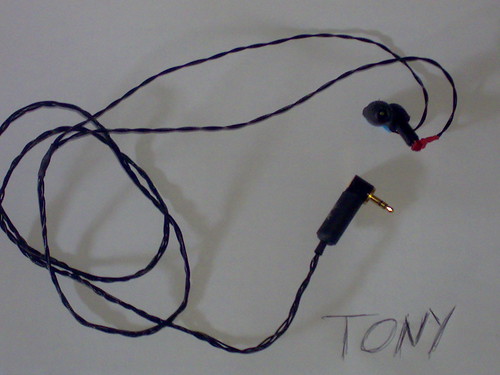Introduction
Etymotic ER4P have been a constant in my hifi experience. Several units (because of breaking, or just because I wanted to explore more brands) have come and gone, but I have come to addiction to their qualities.
Their special midrange, bass depth, comfort, tuneability and price/quality ratio made them raise to the role of “lifestyle device” for me.
I have pretty much owned all kinds of ER4 in existance. I tried the stock-cabled ER4P, ER4S (100 Ohm impedance), and Apuresound recabled ER4P and ER4S. Only “ER4B” are missing to my collection.
More importantly, I have experimented with several eartips.
All IEM’s are extremely sensitive to ear-tips selection, because the interface between the ear canal and the eartip (material, depth, distance of the driver) makes a critical difference in sound rendering, because of reflections and other phisical effects.
Etymotic ER4 happen to have a very lifelike, forward midrange, extremely precise bass and good treble extension (for a IEM, up to 16 kHz), and, for these and other reasons, are a very good starting base.
Eartips selection
Stock Etymotic eartips (plastic triflanges, foam tips) have a basic problem: triflanges make the sound plasticky and very sibilant, and are discomfortable.
Cutting the smallest flange tames the sibilance, but the sound is still plasticky and not natural enough.
The black foam tips have more natural bass and midrange, but are not durable, and still retain the sibilance problem.
Comply tips (more durable, and comfortable, foam tips from Westone), and Shure olive foam eartips tend to make the midrange a bit too much, and not give the best bass rendition, but are otherwise among the good sounding eartips. In my opinion, though, wearing foamies is a very dirty job.
Based on several experiments, the best eartips that I’d suggest, for Etys, would be:
– Westone triflanges (much better, softer material, less reflective)
– Westone biflanges (to be obtained by cutting the third, smallest flange on the triflanged eartip)
– Klipsch gel biflanges
– Shure soft flex sleeves (smallest size), for deep insertion.
– Shure clear flex sleeves (very powerful bass)
All these tips, have natural treble, keep the same good midrange, and manage to give Etys the best bass-to-mids balance. The result is consistent, across these eartips, and makes the Etys a smooth sounding monitor, with a bit of aggressivity in the midrange (“forward sounding”). They are emotional and “push” music.

Sound
The sound description is based upon the “good sounding” tips. Sound with stock tips can be applying the former comments to the description below.
The ER4P has deep bass, great definition, clear and intimate midrange. Soundstage is pretty closed-in, but also eartip dependant.
After the treble spikes and sharpness, caused by the stock tips, are gone, the first thing standing out is the emotional rendition of vocals, electric guitars and trumpets. The usual Ety boost at 1-4 kHz becomes more apparent after the ultradetail and sharpness are tamed.
The Etymotic ER4P can be tilted, aggressive and exciting with some thin rock tracks (like My Bloody Valentine – Loveless); or they can be euphonic with jazz or classical.
They are the perfect mate for rock, vocalists like Joni Mitchell and some jazz. They represent well bass with trance and electronic music, even if these genres are presented with a timbre that’s slightly closer to rock.
The bass is tight and present, although the general presentation is on the “skinned” side. The music, just like happens with headphones with similar genetics (Audio Technica AD2000, Grado RS1, the diy-made Thunderpants), is continuously conveyed towards the listener, who is “the center” of the performance.
A similar attitude, among a totally different kind of gear, is apparent in how Eximus DP-1 DAC presents the music.
While, when using ER4P with a portable, or a laptop, makes for a forward, but flat-tish and tight tonality, pairing them with the right DAC (Melior Bitstream, Idat-44, Halide DAC HD, and others) makes the music fatter, more natural, closer to life colours.
In direct comparison, the Westone 3 is sedated when it comes to vocals. I wouldn’t call the Westone 3 midrange “recessed”, or “lifeless”, like the Head-Direct RE0 can be in the mids, but in direct comparison the W3 tend to be very uneven in the midrange with a lower range fullness and upper mids that are a lot more laid back, resulting in a far portrayal of vocals and leading instruments that should have a more primary role.
It must be said that soundstage is very closed in, especially considering the huge sounding Westone 3, Triple.fi, Heir Tzar 350 (which I have heard as a prototype).
Soundstage, anyway, improves a lot with good sources (dedicated DAC’s), and scale along with the DAC quality.
Unlike the more power demanding ER4S, they are less sensitive to amplification, by comparison.
Etymotic ER4S
ER4S variant, which had been for use with more powerful amplification, is, in my opinion, less interesting and less natural sounding: it has a peak in the highs (6kHz and over) which cannot be “fixed” by any appropriate tips choice. As a result, the ER4S is prone to bring out details from the song that aren’t meant to be dominant, shifting the song presentation towards the innatural, artificial, full of “special effects”. Some people, including myself, call those “fake details”.
Apuresound recabled ER4

Apuresound manufacturer (now out of business) had put out a very special recable that worked as an natural equalizer, replacing the stock, brighter silver plated copper wire, and in the meanwhile reducing the microphonics (if wearing the earphone over the ear).
The result is still an Etymotic, but with revolutionized personality.
The bass is slightly rounder, very well defined, crazy deep, but more impactful, effortless sounding than before. It’s still Ety-like, but there is an improved sense of tightness in the sound, which constantly reminds of the compactness of a stone. I, and other owners, have been agreeing that the burn-in time recommended by Apuresound is actually believable, and improves warmth.
Compared to the stock Etymotic, other than the above mentioned bass quality, the vocals gain even more aggressivity and rage, making for a pretty coloured, but largely emotional and unique item.
Anyway, the effect of this custom recable (whose price starts at 160$ and increases with length) is comparable to that of changing the eartips, which are a more important (and much more cost effective) modification.
I would be very curious as to a Crystal Piccolino recable: such wire is very highly regarded and very expensive.
Tony


